As she tramped through the undergrowth in the Costa Rican rainforest, Amelia Min-Venditti ’16 admitted she was nervous. “I’m extra anxious about the tree bottoms,” she said as she approached the wet, slick trunk of a cecropia tree. “The bullet ants like tree bottoms. Everything likes tree bottoms.” The day before, she had been bitten by an inch-long bullet ant—a searing pain she won’t soon forget. Gingerly, she slid by a low plant with leaves the size of snowshoes. “This is the body odor plant. I don’t want to break it.” There was a snap as she passed.
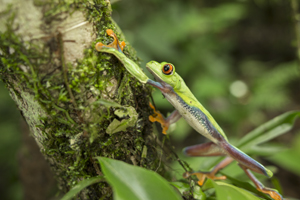 Plants and wildlife abound at the Soltis Center including tree frogs.
Plants and wildlife abound at the Soltis Center including tree frogs.
Her research partner, Luiza M.T. Aparecido ’17, groaned. “It smells like sweaty adolescent boy!”
But Min-Venditti pushed on. She was, after all, on a scientific mission. She wrapped a tape measure around the trunk and called out the tree’s diameter to Aparecido, who recorded it in a notebook. Min-Venditti and Aparecido, both graduate students, were part of a Texas A&M University team studying the water flow in trees as part of a project analyzing the hydrology of the rainforest. But this isn’t just any rainforest. It is Texas A&M’s own rainforest, at the university’s own field station. The Texas A&M Soltis Center for Research and Education, located on lush mountain slopes near the town of San Isidro de Peñas Blancas in Costa Rica, was a gift from Wanda and Bill Soltis ’55, who wanted to help advance scientific research, preserve a slice of the rainforest and add to Texas A&M’s growing global reach. The center is the only international campus that the university actually owns and manages.
“It is Texas A&M’s gateway to Latin America,” said Chris Houser, the global faculty ambassador with the Global Program Support Office.
The Soltis Center, which officially opened in June 2009, is located in a transition zone between lowland rainforests and highland cloud forests that has not been studied thoroughly, thereby opening up many possibilities for new research. “Students and faculty who come here get a unique opportunity for international exposure, culturally and in tropical rainforest conditions. This is a chance for hands-on work, where students can get a better understanding of global changes,” said Eugenio Gonzalez ’96, Soltis Center executive director, as he walked through the canopy, under low branches draped with tinsel-like epiphytes. Gonzalez, who earned his doctorate at Texas A&M in forestry science, is a native Costa Rican and has led other scientific field stations in the country.
“The center is becoming a leading research hub in the tropics of the Western Hemisphere,” he said.
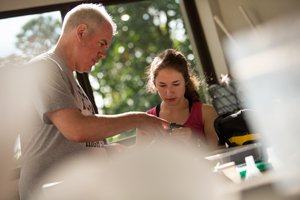 Texas A&M Professor Raymond Tarpley ’71 explains a concept to Courtney Merket ’15 in a veterinary medicine conservationclass at the Soltis Center.
Texas A&M Professor Raymond Tarpley ’71 explains a concept to Courtney Merket ’15 in a veterinary medicine conservationclass at the Soltis Center.
The Soltis Center grew out of one couple’s two loves—Texas A&M and the country of Costa Rica. Bill Soltis, who earned his degree in mechanical engineering, first visited the capital, San Jose, in 1997. Soon, he and Wanda were spending stretches of time in a home they’d purchased on the Pacific Coast. Through a business associate, he learned of a swatch of environmentally sensitive rainforest for sale.
“He bought it right away,” said Kim Soltis Hammer about her father, who has long been committed to rainforest preservation. (Because her father suffered a stroke and her mother passed away in 2009, Hammer carries on her parents’ work.) “It was totally out of character for him to do this so impulsively.” But he saw the great potential of the land, which is primary and secondary rainforest at 1,500 to 2,300 feet above sea level and near two well-known preserves—Monte Verde Conservation Area and the Children’s Eternal Rainforest. With the 290 acres at the Soltis Center and the adjacent preserves, researchers have access to some 120,000 acres that include more than 3,000 types of vascular plants and 400 bird species. Using wildlife cameras with in the jungle, the center’s naturalist, Alberth Rojas, has spotted pumas and a baby jaguar using the trails.
After the purchase, Soltis began working with the university to develop the site. The center’s design was based on ideas from students in Texas A&M’s Department of Architecture. The $9 million complex includes a large classroom-and-commons area that is partly open-air; from a lounge visitors can watch toucans and tanagers fly while listening to howler monkeys and an intoxicating symphony of tropical chirps and whirrs. Eight bungalows—each with two rooms outfitted with four bunk beds—climb up a hillside, nestled among umbrella-leafed licuala palms and vibrant bird of paradise flowers.
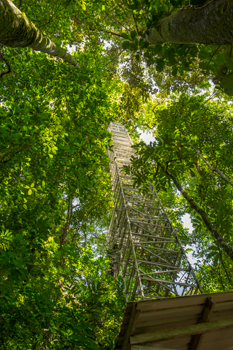 One of the center’s key features is a 126-feet-high canopy tower, which enables scientists
One of the center’s key features is a 126-feet-high canopy tower, which enables scientists
to study conditions at different levels in the rainforest.
One of the center’s key features is a 126-feet-high canopy tower, which enables scientists to study conditions at different levels in the rainforest. Funding for the tower came through various grants and donations; having the tower has opened doors to other grants and research possibilities. What makes this tower unique is that it has electricity and Wi-Fi capabilities—something many rainforest research centers lack. Right now, the tower is studded with instrumentation up its height—devices to monitor humidity, leaf wetness and carbon dioxide levels. When scientists return to College Station, they can see data as it’s collected via the Internet. Hammer hopes that biologists could one day add wildlife webcams on the tower.
“I’ve worked at research centers in the Amazon,” said Aparecido, who is pursuing her doctorate in forest management and ecohydrology, the study of the interaction between water and ecosystems. “The centers in Brazil were fine, but the Soltis Center is really top-notch.”
Another of the Soltis Center’s advantages is that it is multi-disciplinary. Hammer said that her father assumed the center would be used mainly to work with plants and wildlife for biological research, but it has evolved to be far more. “Because of Texas A&M, we have a great opportunity to bring together a variety of arts and sciences in one place,” said Gonzalez. “We can look at the whole picture—the human and physical environment.” As noted by Houser, “It is far more than just a field station in the jungle. It also provides an opportunity for students to explore art, culture, business and health issues of Central America.” Regular visitors include students from the colleges of geosciences, agriculture, education, architecture and engineering. Faculty from civil engineering have brought students to the center for the past five summers. The students, many of them undergraduates, built a weir—a small dam—to measure stream flow and tested other hydrological processes in the rainforest. (And there is plenty of hydrology here; the area gets roughly 180 inches of rain per year.) With support from the oil and gas industry, Texas A&M geology students have spent the past two years mapping the local geology with students from the University of Costa Rica.
Working at the center this past summer were graduate students in the Department of Wildlife and Fisheries Sciences (WFSC) looking at a variety of topics, including migration corridors and parasites in the rodent population. In an ideal example of cross pollination, the WFSC students made presentations to another group of students at the center—a veterinary medicine conservation class led by Texas A&M professor Raymond Tarpley ’71. “Working with biologists is important, because we as vets can know a lot about animals,” said Tarpley, “but if we don’t know about ecosystems, our efforts don’t get translated into policy.”
Through her research on three-toed sloths, Kelsey Neam ’15, who is pursuing a master’s in wildlife and fisheries sciences, found another opportunity for sharing. “I speak Spanish and have local Costa Ricans looking out for sloths for me. I think of this as an exchange. I can help improve their local environment through research, and they can give me information about the local history, the land and species that we don’t know about,” said Neam, who talked about her findings at a local high school at the end of her research trip. “They’ve told me that there used to be a particular jaguar in the area, but now they don’t see it anymore. We wouldn’t know that without their observations.”
Indeed, the center has already had a large impact on the surrounding community, translating the university’s tradition of service to an international scale. “One thing we realized is this wasn’t just about what the students could get from Costa Rica,” said Hammer, “but also about what the students could give back.” The Texas A&M chapter of Engineers Without Borders, for example, has designed and built multiple improvements to the surrounding community’s water distribution system as well as a computer lab building for the local school.
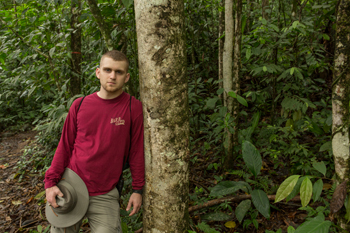 Ryan Andrews ’16, who is working on his master’s in civil engineering,hopes to have a career in international development, working on irrigations projects. “Being able to do water research outside the U.S.is really big for me,” he said.
Ryan Andrews ’16, who is working on his master’s in civil engineering,hopes to have a career in international development, working on irrigations projects. “Being able to do water research outside the U.S.is really big for me,” he said.
College of Agriculture and Life Sciences students advised local farmers on how to better market their crops in San Jose, and members of Aggies for Global Education taught Costa Rican students how to build and use robotics.
“Regardless of whether they’re working in the jungle or with the local community,” said Houser, “the center provides them with an authentic Costa Rican experience.” Houser has been key in turning the center into a profitable undertaking. Texas A&M pays for all operations and after starting out in the red, the center is now operating in the black. In 2014, the center will log about 4,500 student nights at a price of $55 per visitor (room and board). Student groups often use it as a home base while exploring the local communities and businesses. The center is also open to corporations and other organizations that want to use it for retreats and conferences. This fall, the center will host its first full-semester class—a class in tropical ecology through the College of Veterinary Medicine & Biomedical Sciences.
While the center has come a long way in five years, there is still work to be done to reach its full potential. Hammer and her husband Matt ’80 have made crucial contributions for a state-of-the-art weather station and the installation of electricity at the tower. “At this point, to be able to reach outside of the family for funding would be great,” said Hammer.
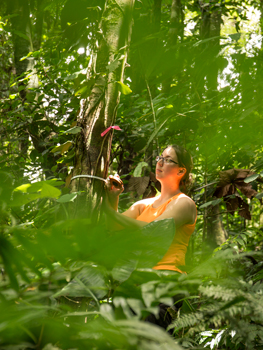 Amelia Min-Venditti ’16, an ecosystem science and management graduate student, is part of a Texas A&M team studying water flow in trees to analyze the hydrology of the Costa Rican rainforest.
Amelia Min-Venditti ’16, an ecosystem science and management graduate student, is part of a Texas A&M team studying water flow in trees to analyze the hydrology of the Costa Rican rainforest.
Gonzalez believes funding for a complete biodiversity survey of this part of the rainforest is vitally important. “A general characterization of the plant and animal life would be a starting point for any student or professor who is going to work here,” he said. “This information attracts scientists; they will have a point of comparison for their research.”
Other priorities include building up the center’s infrastructure. More housing is needed, specifically for professors doing research and leading study abroad programs. Plans exist for updating and expanding the labs and for building an amphitheater for outdoor lectures. Although the center is close to zip line attractions and whitewater rafting, Hammer hopes that Texas A&M will build more facilities on the property, such as a ropes course, other canopy towers, suspension bridges and a covered platform in the forest for overnight camping. Naming opportunities abound throughout the center—for bungalows and classrooms and even for forest trails and waterfalls.
Funding student travel is another priority. With the reasonable room-and-board cost at the center, a trip to Costa Rica costs less than many study abroad opportunities, but Houser points out that it is still cost-prohibitive for many students. He hopes that an endowment to the center will provide scholarships for more students to conduct research. The walls in the cafeteria reflect the center’s delightful mash-up of work and pleasure. Each group who visits paints something on the wall to represent their experience along with a list of student names and their field of study. The artwork is colorful and light-hearted and often includes depictions of sloths, lizards, snakes and butterflies.
One mural—created by a Spring Break 2014 class in environmental geoscience—shows a toucan dive-bombing a tall tree and a red-eyed tree frog leaping up the side of an erupting volcano. On one side are the words “Pura Vida,” the national slogan of Costa Rica. This translates to “pure life,” but it can be used to express thanks, pride, congratulations or to say good-bye or hello. On the other side are two words that in another, closely affiliated culture convey a similar range of emotion and meaning: “Gig ’em.”
By Jeannie Ralston
This article was originally published in the fall 2014 issue of Spirit magazine.
Texas A&M Foundation
The Texas A&M Foundation is a nonprofit organization that solicits and manages investments in academics and leadership programs to enhance Texas A&M’s capability to be among the best universities.
You can support the Soltis Center with a gift of an endowment to the Texas A&M Foundation. For additional information about how to benefit the center, contact Dr. Christopher Houser, global faculty ambassador and associate dean of academic affairs in the College of Geosciences, at (850) 377-8787 or chouser@tamu.edu.